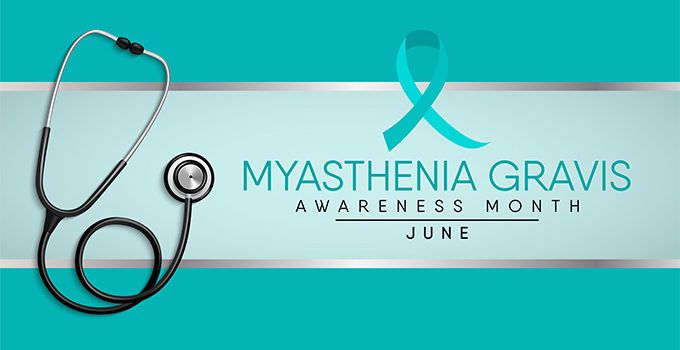

What is Myasthenia Gravis?
by William Buxton
Myasthenia gravis (MG) is a disorder of nerves and muscles that occurs when nerves and muscles don’t communicate well. Patients usually first notice symptoms when muscles that are used continuously throughout the day start getting weak, usually later in the day. Muscles that tend to be affected the most are our eyelids, extraocular muscles (the muscles that move our eyes and let us see things in a coordinated way with both eyes), muscles of our face and throat, neck muscles, and quadriceps (the muscles in the fronts of the thighs). As these muscles get weaker with sustained use, individuals develop ptosis (eyelid droop), diplopia (double vision), dysphagia (difficulty swallowing), dysarthria (slurred speech), difficulty holding one’s neck upright, and/or difficulty standing upright. In some individuals, it only affects eyelids and extraocular muscles, representing ocular myasthenia. In rare instances, the weakness can become more severe and widespread, even affecting breathing, a situation known as myasthenic crisis, a medical emergency sometimes requiring artificial ventilation. With improvements in treatment of MG in recent years, this occurs only rarely, only affecting 15-20 percent of patients.
What causes Myasthenia Gravis?
MG is caused when one’s immune system produces antibodies (proteins that usually target infections for our immune system to attack) called Acetylcholine Receptor Antibodies that block receptors in muscles. These muscles are activated when a neurotransmitter, acetylcholine, is released from nerves and attaches to the receptors, making our muscles contract. The receptors blocked by antibodies are not able to be activated by signals arriving from nerves, so our muscles are not able to contract as well.
Although it can affect individuals at any age, it most commonly affects women under 40 and men over 60. Many cases are related to the thymus gland. The thymus is present in our chest, just forward of our heart, in childhood and early adulthood and usually shrinks away in our 20s. In some individuals, it does not entirely disappear, and persistence increases the risk of myasthenia. In some rare instances, especially in older men, a cancerous tumor of the thymus, a thymoma, may be present.
It is not contagious. About 3-5% of patients have a family history, often representing a group of conditions known as congenital myasthenic syndromes. Most of these individuals first show symptoms in childhood but might not until early adulthood.
How is Myasthenia Gravis diagnosed?
The first step is a thorough history and bedside neurologic exam. At the Pacific Brain Health Center, a physician will perform tasks such as checking muscle strength, eye motions, and reflexes. If myasthenia is suspected, blood tests checking for Acetylcholine Receptor Antibodies will be drawn. As scientists have identified more antibodies, physicians are able to diagnose about 90% of generalized (affecting more than just the ocular muscles). If the antibodies are negative, specific types of electrodiagnostic EMG/NCS testing can be performed. Individuals with suspected MG will also undergo a scan of the chest (CT or MRI) to check for residual thymus or thymomas.
How is Myasthenia Gravis treated?
The simplest treatment is a medication known as pyridostigmine, which prevents the breakdown of our natural supplies of acetylcholine, increasing the amount available to muscles. However, this only treats the symptoms and does not treat the underlying problem. Treating the underlying disorder requires treatments that suppress or alter the workings of the overactive immune processes causing myasthenia. One class of such medications are immunosuppressants, such as prednisone (a form of cortisone), or newer “steroid sparing agents”. These often take weeks to months to reach full effect and have varying risk-to-benefit ratios which physicians can discuss with patients. For more rapid responses, intravenous immunoglobulin (IVIG) treatments and plasmapheresis (a treatment similar to dialysis) are often performed; these rapid options are also helpful for myasthenic crisis. A new treatment option, eculizumab, is a monoclonal antibody, a protein developed to block a portion of the immune system that contributes to myasthenia. In individuals with residual thymic tissue, surgical removal can reduce myasthenia activity.
Are there other precautions?
One of the biggest risks for exacerbation of myasthenia is exposure to certain medications. These are mostly specific antibiotics and antiviral medications. Therefore, individuals with MG should check to make sure any medication prescribed is safe in myasthenia.
>> Download a list of medications that can exacerbate myasthenia
Myasthenia Gravis Clinic Location
1301 20th St., Santa Monica, CA 904040 | 310-582-7641
Useful Links
About the Author

William Buxton
Dr. William G. Buxton is Director of Neuromuscular & Neurodiagnostic Medicine and Fall Prevention at the Pacific Brain Health Center. His streamlined methods to optimize safety in outpatient settings, especially related to fall prevention among neurology outpatients have reduced falls and have even trended toward fewer falls among individuals with dementia, a population in which fall prevention efforts had previously been viewed as impractical. Dr. Buxton also has interests in neuropathies, especially those secondary to autoimmune disorders and other systemic processes.
Last updated: June 10th, 2023